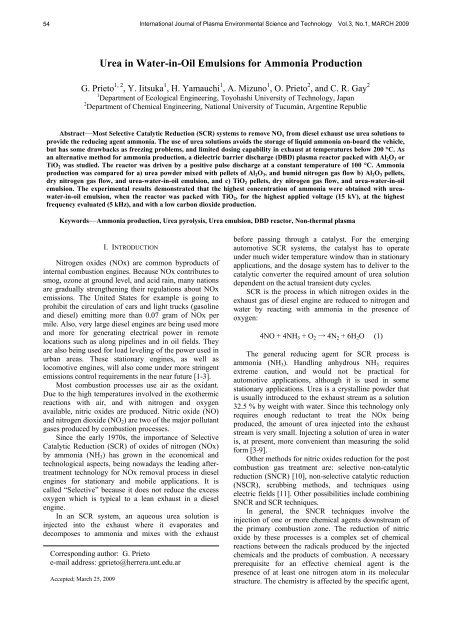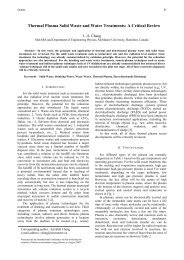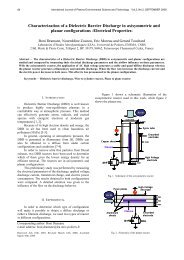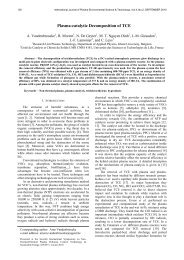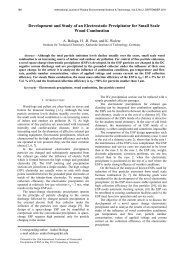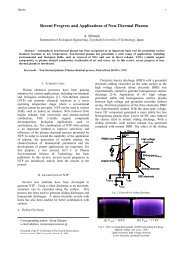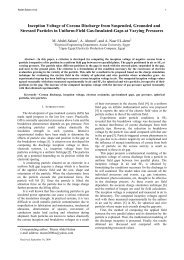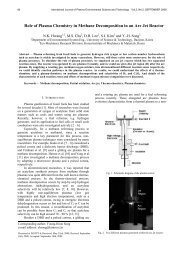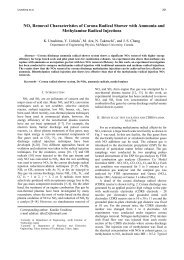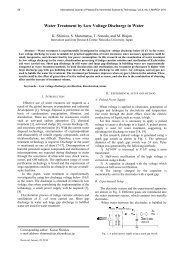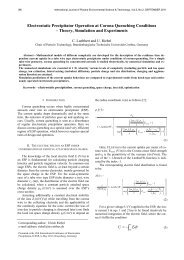Urea in Water-in-Oil Emulsions for Ammonia Production
Urea in Water-in-Oil Emulsions for Ammonia Production
Urea in Water-in-Oil Emulsions for Ammonia Production
Create successful ePaper yourself
Turn your PDF publications into a flip-book with our unique Google optimized e-Paper software.
54 International Journal of Plasma Environmental Science and Technology Vol.3, No.1, MARCH 2009<strong>Urea</strong> <strong>in</strong> <strong>Water</strong>-<strong>in</strong>-<strong>Oil</strong> <strong>Emulsions</strong> <strong>for</strong> <strong>Ammonia</strong> <strong>Production</strong>G. Prieto 1, 2 , Y. Iitsuka 1 , H. Yamauchi 1 , A. Mizuno 1 , O. Prieto 2 , and C. R. Gay 21 Department of Ecological Eng<strong>in</strong>eer<strong>in</strong>g, Toyohashi University of Technology, Japan2 Department of Chemical Eng<strong>in</strong>eer<strong>in</strong>g, National University of Tucumán, Argent<strong>in</strong>e RepublicAbstract—Most Selective Catalytic Reduction (SCR) systems to remove NO x from diesel exhaust use urea solutions toprovide the reduc<strong>in</strong>g agent ammonia. The use of urea solutions avoids the storage of liquid ammonia on-board the vehicle,but has some drawbacks as freez<strong>in</strong>g problems, and limited dos<strong>in</strong>g capability <strong>in</strong> exhaust at temperatures below 200 °C. Asan alternative method <strong>for</strong> ammonia production, a dielectric barrier discharge (DBD) plasma reactor packed with Al 2 O 3 orTiO 2 was studied. The reactor was driven by a positive pulse discharge at a constant temperature of 100 °C. <strong>Ammonia</strong>production was compared <strong>for</strong> a) urea powder mixed with pellets of Al 2 O 3 , and humid nitrogen gas flow b) Al 2 O 3 pellets,dry nitrogen gas flow, and urea-water-<strong>in</strong>-oil emulsion, and c) TiO 2 pellets, dry nitrogen gas flow, and urea-water-<strong>in</strong>-oilemulsion. The experimental results demonstrated that the highest concentration of ammonia were obta<strong>in</strong>ed with ureawater-<strong>in</strong>-oilemulsion, when the reactor was packed with TiO 2 , <strong>for</strong> the highest applied voltage (15 kV), at the highestfrequency evaluated (5 kHz), and with a low carbon dioxide production.Keywords—<strong>Ammonia</strong> production, <strong>Urea</strong> pyrolysis, <strong>Urea</strong> emulsion, DBD reactor, Non-thermal plasmaI. INTRODUCTIONNitrogen oxides (NOx) are common byproducts of<strong>in</strong>ternal combustion eng<strong>in</strong>es. Because NOx contributes tosmog, ozone at ground level, and acid ra<strong>in</strong>, many nationsare gradually strengthen<strong>in</strong>g their regulations about NOxemissions. The United States <strong>for</strong> example is go<strong>in</strong>g toprohibit the circulation of cars and light trucks (gasol<strong>in</strong>eand diesel) emitt<strong>in</strong>g more than 0.07 gram of NOx permile. Also, very large diesel eng<strong>in</strong>es are be<strong>in</strong>g used moreand more <strong>for</strong> generat<strong>in</strong>g electrical power <strong>in</strong> remotelocations such as along pipel<strong>in</strong>es and <strong>in</strong> oil fields. Theyare also be<strong>in</strong>g used <strong>for</strong> load level<strong>in</strong>g of the power used <strong>in</strong>urban areas. These stationary eng<strong>in</strong>es, as well aslocomotive eng<strong>in</strong>es, will also come under more str<strong>in</strong>gentemissions control requirements <strong>in</strong> the near future [1-3].Most combustion processes use air as the oxidant.Due to the high temperatures <strong>in</strong>volved <strong>in</strong> the exothermicreactions with air, and with nitrogen and oxygenavailable, nitric oxides are produced. Nitric oxide (NO)and nitrogen dioxide (NO 2 ) are two of the major pollutantgases produced by combustion processes.S<strong>in</strong>ce the early 1970s, the importance of SelectiveCatalytic Reduction (SCR) of oxides of nitrogen (NOx)by ammonia (NH 3 ) has grown <strong>in</strong> the economical andtechnological aspects, be<strong>in</strong>g nowadays the lead<strong>in</strong>g aftertreatmenttechnology <strong>for</strong> NOx removal process <strong>in</strong> dieseleng<strong>in</strong>es <strong>for</strong> stationary and mobile applications. It iscalled “Selective” because it does not reduce the excessoxygen which is typical to a lean exhaust <strong>in</strong> a dieseleng<strong>in</strong>e.In an SCR system, an aqueous urea solution is<strong>in</strong>jected <strong>in</strong>to the exhaust where it evaporates anddecomposes to ammonia and mixes with the exhaustCorrespond<strong>in</strong>g author: G. Prietoe-mail address: gprieto@herrera.unt.edu.arAccepted; March 25, 2009be<strong>for</strong>e pass<strong>in</strong>g through a catalyst. For the emerg<strong>in</strong>gautomotive SCR systems, the catalyst has to operateunder much wider temperature w<strong>in</strong>dow than <strong>in</strong> stationaryapplications, and the dosage system has to deliver to thecatalytic converter the required amount of urea solutiondependent on the actual transient duty cycles.SCR is the process <strong>in</strong> which nitrogen oxides <strong>in</strong> theexhaust gas of diesel eng<strong>in</strong>e are reduced to nitrogen andwater by react<strong>in</strong>g with ammonia <strong>in</strong> the presence ofoxygen:4NO + 4NH 3 + O 2 → 4N 2 + 6H 2 O (1)The general reduc<strong>in</strong>g agent <strong>for</strong> SCR process isammonia (NH 3 ). Handl<strong>in</strong>g anhydrous NH 3 requiresextreme caution, and would not be practical <strong>for</strong>automotive applications, although it is used <strong>in</strong> somestationary applications. <strong>Urea</strong> is a crystall<strong>in</strong>e powder thatis usually <strong>in</strong>troduced to the exhaust stream as a solution32.5 % by weight with water. S<strong>in</strong>ce this technology onlyrequires enough reductant to treat the NOx be<strong>in</strong>gproduced, the amount of urea <strong>in</strong>jected <strong>in</strong>to the exhauststream is very small. Inject<strong>in</strong>g a solution of urea <strong>in</strong> wateris, at present, more convenient than measur<strong>in</strong>g the solid<strong>for</strong>m [3-9].Other methods <strong>for</strong> nitric oxides reduction <strong>for</strong> the postcombustion gas treatment are: selective non-catalyticreduction (SNCR) [10], non-selective catalytic reduction(NSCR), scrubb<strong>in</strong>g methods, and techniques us<strong>in</strong>gelectric fields [11]. Other possibilities <strong>in</strong>clude comb<strong>in</strong><strong>in</strong>gSNCR and SCR techniques.In general, the SNCR techniques <strong>in</strong>volve the<strong>in</strong>jection of one or more chemical agents downstream ofthe primary combustion zone. The reduction of nitricoxide by these processes is a complex set of chemicalreactions between the radicals produced by the <strong>in</strong>jectedchemicals and the products of combustion. A necessaryprerequisite <strong>for</strong> an effective chemical agent is thepresence of at least one nitrogen atom <strong>in</strong> its molecularstructure. The chemistry is affected by the specific agent,
Prieto et al. 55temperature, pressure, concentrations of species, andresidence time [12].There are three ma<strong>in</strong> SNCR processes currentlybe<strong>in</strong>g implemented: (1) the thermal DeNOx processwhich uses the <strong>in</strong>jection of ammonia (NH 3 ) <strong>in</strong>to the hotexhaust gas. The <strong>for</strong>m of the ammonia may be asaqueous (with water) solution or as anhydrous (no water).This process is used <strong>in</strong> exhaust streams such as fromfurnaces and boilers [13, 14]; (2) the RAPRENOxprocess which uses solid cyanuric acid ((HNCO) 3 )<strong>in</strong>jected <strong>in</strong>to the hot exhaust gases. The solid cyanuricacid sublimates at about 650 K to give gaseous isocyanicacid (HNCO). The isocyanic acid <strong>in</strong>itiates a series ofreactions <strong>in</strong> appropriate conditions which result <strong>in</strong> theremoval of nitric oxide [15]; and (3) the NOxOUTprocess which uses urea (NH 2 CONH 2 ). In this process,typically either solid urea or a urea solution (with water)is <strong>in</strong>jected <strong>in</strong>to the hot exhaust gases. <strong>Urea</strong> maydecompose <strong>in</strong>to HNCO and NH 3 under certa<strong>in</strong> conditions[16, 17].For conventional SNCR processes, either ammoniaor urea have been proposed as the reduc<strong>in</strong>g agent.<strong>Ammonia</strong> has been widely used <strong>in</strong> SNCR processes, but<strong>in</strong> some <strong>for</strong>ms it is both corrosive and toxic. <strong>Urea</strong>cont<strong>in</strong>ues to be considered as an alternative to ammonia.The use of urea, there<strong>for</strong>e, is of <strong>in</strong>terest. The two mostcommon methods <strong>for</strong> <strong>in</strong>troduc<strong>in</strong>g urea <strong>in</strong>to the exhaustgases is by <strong>in</strong>jection of dry urea, or <strong>in</strong>jection of a ureawatersolution. Decomposition of dry urea <strong>in</strong> nitrogentakes place at temperatures of about 720 K, and the ureadecomposes <strong>in</strong>to roughly equal amounts of ammonia(NH 3 ) and isocyanic acid (HNCO) [16]:NH 2 CONH 2 → NH 3 + + HNCO (2)<strong>Urea</strong>-water solutions have a different decompositionpath than dry urea, produc<strong>in</strong>g ammonia as the ma<strong>in</strong>product [5, 18, 19]:NH 2 CONH 2 + H 2 O → 2NH 3 + +CO 2 (3)<strong>Ammonia</strong> (NH 3 ) as well as aqueous solutions of urea((NH 2 ) 2 CO) are the most widely used reduc<strong>in</strong>g agents <strong>for</strong>SCR reduction of NOx. <strong>Urea</strong> may be considered as aNH 3 storage solid compound which is producedcommercially by react<strong>in</strong>g ammonia with carbon dioxide.Adoption of urea-SCR over NH 3 -SCR could bepreferable due to a number of drawbacks associated withthe use of ammonia. <strong>Ammonia</strong> is corrosive and toxic <strong>in</strong>nature. It is also a primary as well as a secondarypollutant. Use of ammonia entails careful and accuratehandl<strong>in</strong>g requir<strong>in</strong>g pressure. In order to <strong>in</strong>troduce NH 3<strong>in</strong>to the exhaust gas stream, accurate dosage controlmechanism is required which can be expensive. <strong>Urea</strong> onthe other hand is non-toxic be<strong>in</strong>g extensively used <strong>in</strong>agriculture as well as <strong>in</strong> the <strong>in</strong>dustry and it is available <strong>in</strong>a number of quality grades.Among many metal oxide supports, TiO 2 support hasbeen found to be highly effective <strong>for</strong> the selectivecatalytic reduction of NOx with NH 3 because of itsdurability to sulfur compounds. The action of sulfur onthe TiO 2 supported catalyst has been found to evenenhance the level of NO removal. Hence, due to its highactivity and durability to sulfur compounds, V 2 O 5supported on TiO 2 is well known to be the most effectiveand widely used commercial catalyst <strong>for</strong> the SCRprocesses. A ternary catalyst, V 2 O 5 -WO 3 /TiO 2 , was alsorecently <strong>in</strong>troduced. Promoters such as WO 3 , SiO 2 andMoO 3 are usually added to V 2 O 5 /TiO 2 catalyst <strong>in</strong> order toenhance the catalyst activity. The promoters lead to the<strong>for</strong>mation of acid sites on the surface of the catalyst, andthe catalysts exhibit a higher catalytic activity than thatof a s<strong>in</strong>gle TiO 2 supported vanadium catalyst. Theaddition of WO 3 provides some poison resistance andimproves NH 3 oxidation [20].<strong>Urea</strong> decomposition does not reach completion <strong>in</strong> thegas phase at temperatures that are prevalent dur<strong>in</strong>g alight-duty diesel eng<strong>in</strong>e operation (below 300 ºC).Stradella et al. [21] studied the thermal decomposition ofurea and related compounds. Their <strong>in</strong>vestigations werebased on TGA and DSC, together with the evolved gasanalysis (EGA) with the help of an FTIR spectrometer[21, 22]. They were able to identify biuret, ammelide andcyanuric acid as <strong>in</strong>termediate compounds. Schaber et al.[23] found that the urea is melted at 133 ºC andprecipitates start to <strong>for</strong>m prior to 225 ºC.It is generally accepted that urea decomposes <strong>in</strong> twosteps that are physically separated <strong>in</strong> time and space: thethermolysis of f<strong>in</strong>ely sprayed urea <strong>in</strong>to ammonia andisocyanic acid (HNCO), which would occur along theexhaust pipe prior to the catalyst, and the hydrolysis ofisocyanic acid, which would occur on the catalyst surface.These two steps correspond to the overall ureadecomposition(NH 2 ) 2 CO + H 2 O → 2NH 3 + CO 2 (4)<strong>in</strong> which 1 mol of urea would generate 2 mol of ammonia.The NH 3 :NO stoichiometric molar ratio <strong>in</strong> typical SCRreactions is 1:2. The thermal decomposition of urea can<strong>for</strong>m stable decomposition products. Some of these stableproducts do not further decompose to produce ammonia[20].In the pyrolysis of urea, no significant reaction isobserved when heat<strong>in</strong>g from room temperature up to133 °C (urea melt<strong>in</strong>g po<strong>in</strong>t). <strong>Urea</strong> typically melts withdifficulty, and usually a complete melt is not achieveduntil 135 °C. Mass loss beg<strong>in</strong>s about 140 °C and isprimarily associated with urea vaporization.(NH 2 ) 2 CO (m) + heat → (NH 2 ) 2 CO (g) (5)At 152 °C, urea decomposition beg<strong>in</strong>s, as noted byvigorous gas evolution from the melt, giv<strong>in</strong>g ammonia(NH 3 ) and isocyanic acid (HNCO),(NH 2 ) 2 CO (m) + heat → NH 3 (g) + HNCO (g) (6)Biuret ((NH 2 ) 2 NH(CO) 2 ) is also produced at thistemperature,
56 International Journal of Plasma Environmental Science and Technology Vol.3, No.1, MARCH 2009(NH 2 ) 2 CO (m) + HNCO (g) → (NH 2 ) 2 NH(CO) 2 (s) (7)At temperatures above 190 °C, other solidscompounds are produced primarily from biuret and <strong>in</strong>parallel reactions: cyanuric acid ((HNCO) 2 ), and thetriazides ammelide (C 3 H 4 N 4 O 2 ), and ammel<strong>in</strong>e(C 3 H 5 N 5 O). The biuret itself is a result of prior reactionof HNCO with urea. The HNCO is a result of ureadecomposition at temperatures over 152 °C. Cyanuricacid and ammelide first appear at about 175 °C, but thereaction rate is very slow based on the amounts <strong>for</strong>med.At temperatures above 190 °C, several parallel processescompete <strong>for</strong> the generation of products. These routes,where direct biuret decomposition is considered, areconsistent with the copious evolution of gases observedfrom the melt between 190 and 210 °C. As thetemperature exceeds 210 °C, a white precipitate beg<strong>in</strong>s to<strong>for</strong>m a sticky solid matrix. <strong>Production</strong> of cyanuric acidand ammelide cont<strong>in</strong>ues, although reaction rates decreaseas the solid matrix <strong>for</strong>ms. <strong>Production</strong> of cyanuric acidappears complete at 275 °C, after which sublimation andeventual decomposition occur. Ammelide and ammel<strong>in</strong>econt<strong>in</strong>ue to <strong>in</strong>crease <strong>in</strong> mass up to 350 °C. Attemperatures above 360 °C, sublimation anddecomposition processes beg<strong>in</strong> to dom<strong>in</strong>ate [18].From the literature two different ways <strong>for</strong> thethermal decomposition can be derived: (a) evaporation ofmolten/solid urea to gaseous urea, which decomposes <strong>in</strong>the gas phase <strong>in</strong>to NH 3 and HNCO or (b) the direct wayfrom molten/solid urea to gaseous NH 3 and HNCO.These two ways differ ma<strong>in</strong>ly <strong>in</strong> the way how the heat ofthe reaction is provided. The results reveal that thethermal decomposition of urea is limited by k<strong>in</strong>etics [20].Fang et al. [20] also <strong>in</strong>vestigated the effect ofmoisture on urea decomposition process and found thatthe moisture could assist the hydrolysis of HNCO only <strong>in</strong>the temperature region below the first decompositionstage (below 250 o C). The DRIFTS measurementsshowed that the f<strong>in</strong>al brown color product <strong>for</strong>med at 450o C could be a chemical complex of polymeric melam<strong>in</strong>eswith high molecular weights which might actually blockthe active sites on the catalyst surface. Their studyshowed that urea thermolysis exhibits two decompositionstages, <strong>in</strong>volv<strong>in</strong>g ammonia generation and consumptionrespectively. Decomposition occurr<strong>in</strong>g after the secondstage leads to the production of melam<strong>in</strong>e complexes,that h<strong>in</strong>der the overall per<strong>for</strong>mance of the catalyst. Theyasserted that polymeric melam<strong>in</strong>e complexes can be<strong>for</strong>med both with and without the catalyst and they donot undergo further decomposition (at least up to 320 o C).There is not complete consensus among the authorsabout <strong>in</strong> which state of aggregation urea appears after theevaporation of water and dur<strong>in</strong>g the thermaldecomposition: Yim et al. [24] <strong>in</strong>dicated liquid orgaseous urea; Schaber et al. [23] reported that moltenurea evaporates to gaseous urea at temperatures above413 K, but ma<strong>in</strong>ly decompose directly to NH 3 andHNCO above 425 K; Koebel et al. [25] revealed thatatomization of urea-water-solution (UWS) <strong>in</strong> hot exhauststream yields to solid or molten urea.For automotive applications, Birkhold et al. [19]claim that the urea-water-solution based SCR is apromis<strong>in</strong>g method <strong>for</strong> control of NOx emissions. UWSconta<strong>in</strong><strong>in</strong>g 32.5 wt.% urea is sprayed <strong>in</strong>to the hot exhauststream, <strong>for</strong> the subsequent generation of NH 3 <strong>in</strong> the hotexhaust gas. As the evaporation and spatial distributionof the reduc<strong>in</strong>g agent upstream the catalyst are crucialfactors <strong>for</strong> the conversion of NOx, the dos<strong>in</strong>g system hasto ensure the proper preparation of the reduc<strong>in</strong>g agent atall operat<strong>in</strong>g conditions.Specific concerns with the ammonia process <strong>in</strong>cludethe storage, handl<strong>in</strong>g, and delivery of the ammonia. Also,any ammonia not consumed <strong>in</strong> the process may beemitted (“ammonia slip”) as a result of this process. Forthese and other reasons, alternative agents have beenproposed over the years. Two of these that have receivedsignificant <strong>in</strong>terest <strong>in</strong>clude cyanuric acid ((HNCO) 3 ) andurea ((NH 2 ) 2 CO) [12].The ma<strong>in</strong> goal of the present research is to developan alternative method <strong>for</strong> ammonia production, us<strong>in</strong>g adielectric barrier discharge (DBD) plasma reactor packedwith Al 2 O 3 or TiO 2 . The reactor is driven by a positivepulse discharge at a constant temperature of 100 ºC.<strong>Ammonia</strong> production is evaluated <strong>for</strong> a) urea powdermixed with pellets of Al 2 O 3 , and a humid nitrogen gasflow b) Al 2 O 3 pellets, a dry nitrogen gas flow, and ureawater-<strong>in</strong>-oilemulsion fed with a micropump, and c) TiO 2pellets, a dry nitrogen gas flow, and urea-water-<strong>in</strong>-oilemulsion fed with a micropump. <strong>Urea</strong> emulsions presentgreat advantages: are easy to be prepared, require lowamount of water, easy <strong>for</strong> handl<strong>in</strong>g, easy <strong>for</strong> feed<strong>in</strong>gwith a micropump, not freezable and not stackable <strong>in</strong>tothe pip<strong>in</strong>g.II. EXPERIMENTAL SETUPThe diagram of the experimental setup is depicted <strong>in</strong>Fig. 1. The reactor is a concentric dielectric barrierdischarge (DBD) packed with catalyst pellets of γ-Al 2 O 3 ,or TiO 2 , 2.5-4 mm <strong>in</strong> diameter. The high voltageelectrode is a sta<strong>in</strong>less steel rod of 25 mm <strong>in</strong> length and11 mm <strong>in</strong> outer diameter. The reactor, depicted <strong>in</strong> Fig. 2,is placed <strong>in</strong> a quartz glass tube of 50 mm <strong>in</strong> length and<strong>in</strong>ner diameter of 19 mm. A sta<strong>in</strong>less steel sheet wrappedon the outer surface of the quartz glass tube is the groundelectrode.The reactor was fed with nitrogen, as a carrier gas, ata constant flow rate of 2000 mL/m<strong>in</strong>, controlled with amass flow controller. For the experiments with ureapowder, humid gas was obta<strong>in</strong>ed by bubbl<strong>in</strong>g <strong>in</strong> deionizedwater at room temperature, and the water content<strong>in</strong> the gas stream was measured us<strong>in</strong>g a gas-detect<strong>in</strong>gtube (Gastec Co).In the case of <strong>Urea</strong> Powder, 1 g of urea powder and 3g of hexadecane were packed <strong>in</strong> the reactor mixed withthe catalyst pellets. In the case of <strong>Urea</strong> Emulsion, 0.1 g ofurea water-<strong>in</strong>-hexadecane was fed with a micropump at amass flow rate of 0.1 g/m<strong>in</strong>. The urea water-<strong>in</strong>-oilemulsion was prepared by us<strong>in</strong>g emulsifiers “Tween80”
Prieto et al. 59NH3 concentration (ppm)15000100005000Hold ValuesT 13554153 10Frequency (kHz) 25 Voltage (kV)Fig. 3. <strong>Urea</strong> powder (Packed-Bed Al 2 O 3 ).Surface plot of NH 3 concentration (ppm) vs Frequency (kHz);Voltage (kV), <strong>for</strong> a Temperature of 135 o C.NH3 concentration (ppm)12000100008000600040002000010 11 12 13 14 15 16NH3 <strong>Urea</strong> powder (Packed-Bed Al2O3)NH3 <strong>Urea</strong> emulsion (Packed-Bed TiO2)Applied Voltage (kV)NH3 <strong>Urea</strong> emulsion (Packed-Bed Al2O3)Fig. 6. <strong>Ammonia</strong> concentration (ppm) as a function of the AppliedVoltage (kV) <strong>for</strong> <strong>Urea</strong> powder (Packed-Bed Al 2 O 3 ); <strong>Urea</strong> emulsion(Packed-Bed Al 2 O 3 ); <strong>Urea</strong> emulsion (Packed-Bed TiO 2 ).NH3 concentration (ppm)600040002000054 14312Frequency (kHz) 210 Voltage (kV)Fig. 4. <strong>Urea</strong> emulsion (Packed-Bed Al 2 O 3 ).Surface plot of NH 3 concentration (ppm) vs Frequency (kHz);Voltage (kV)NH3 concentration (ppm)1000050000543Frequency (kHz) 21210experiments with urea powder, or from the emulsion <strong>in</strong>the case of the experiments with urea emulsion, makesthe iso-cyanic acid undergo <strong>in</strong> a second reaction with onemolecule of water (hydrolysis) giv<strong>in</strong>g one molecule ofNH 3 and one molecule of CO 2 .The CO 2 produced experiments the same sensibilityto the variables tested, as the NH 3 produced. For theexperiments carried out with <strong>Urea</strong> Powder, the highestconcentrations of CO 2 (at 135 o C), was about 6000 ppmFor the experiments carried out with <strong>Urea</strong> Emulsion andTiO 2 (at 100 o C), the highest concentrations of CO 2 wereabout 2800 ppm, and with <strong>Urea</strong> Emulsion and Al 2 O 3 (at100 o C), the highest concentrations of CO 2 were about2000 ppm. Fig. 7 displays the carbon dioxideconcentration as a function of the applied voltage <strong>for</strong> thethree cases studied, at a temperature of 100 o C <strong>for</strong> urea14Voltage (kV)Fig. 5. <strong>Urea</strong> emulsion (Packed-Bed TiO 2 ).Surface plot of NH 3 concentration (ppm) vs Frequency (kHz);Voltage (kV)CO2 concentration (ppm)600050004000300020001000010 11 12 13 14 15 16CO2 <strong>Urea</strong> powder (Packed-Bed Al2O3)CO2 <strong>Urea</strong> emulsion (Packed-Bed TiO2)Applied Voltage (kV)CO2 <strong>Urea</strong> emulsion (Packed-Bed Al2O3)Fig. 7. Carbon Dioxide concentration (ppm) as a function of theApplied Voltage (kV) <strong>for</strong> <strong>Urea</strong> powder (Packed-Bed Al 2 O 3 ); <strong>Urea</strong>emulsion (Packed-Bed Al 2 O 3 ); <strong>Urea</strong> emulsion (Packed-Bed TiO 2 ).emulsion, and at 135o C <strong>for</strong> urea powder. Thetemperature of 135 o C was selected <strong>in</strong> order to comparethe behavior with urea powder and with urea emulsion<strong>for</strong> the different packed-bed materials.The whole evaluation of the experiments carried out,besides to demonstrate the feasibility of us<strong>in</strong>g solid urea<strong>in</strong> a water-<strong>in</strong>-oil emulsion, which makes this process acandidate <strong>for</strong> <strong>in</strong> situ application, has the advantage ofus<strong>in</strong>g an emulsion with a very low content of water, notfreezable and with constant ammonia provision, besidesto generate not a high concentration of carbon dioxide.IV. CONCLUSIONA new method <strong>for</strong> ammonia production <strong>in</strong> situ wassuccessfully developed. A dielectric barrier discharge(DBD) packed with catalyst pellets of γ-Al 2 O 3 , or TiO 2and solid urea <strong>in</strong> the <strong>for</strong>m of powder or <strong>in</strong> a water-<strong>in</strong>-oilemulsion were used to study the ammonia production,under experimental design methodology. The plasmareactor was driven by positive pulsed high voltagegenerated by a pulse power generator. By apply<strong>in</strong>g highvoltage, an <strong>in</strong>tense pulse discharge plasma is generated atthe contact po<strong>in</strong>ts of the catalyst pellets without arc<strong>in</strong>g.The <strong>in</strong>tense electric field produced is high enough <strong>for</strong>melt<strong>in</strong>g the urea powder or urea emulsion giv<strong>in</strong>g place tothe reaction of urea vaporized to <strong>for</strong>m ammonia and isocyanicacid which <strong>in</strong> turn, due to the presence of water
60 International Journal of Plasma Environmental Science and Technology Vol.3, No.1, MARCH 2009from the humid carrier gas <strong>in</strong> the case of solid urea orwater from the emulsion <strong>in</strong> the case of urea emulsion,undergo <strong>in</strong> a secondary reaction <strong>in</strong> gas phase to give onemolecule of ammonia and one molecule of carbondioxide. The maximum ammonia concentrations obta<strong>in</strong>edper gram of solid urea fed, were about 14000 ppm <strong>for</strong>urea powder on γ-Al 2 O 3 (at 135 ºC), about 9000 ppm <strong>for</strong>urea emulsion on TiO 2 (at 100 ºC), and about 5000 ppm<strong>for</strong> urea emulsion on γ-Al 2 O 3 (at 100 ºC).The whole evaluation of the experiments carried out,besides to demonstrate the feasibility of us<strong>in</strong>g solid urea<strong>in</strong> a water-<strong>in</strong>-oil emulsion, which makes this process acandidate <strong>for</strong> <strong>in</strong> situ application, has the advantage ofus<strong>in</strong>g an emulsion with a very low content of water, notfreezable and with a constant ammonia provision. <strong>Urea</strong>emulsions prepared present great advantages: are easy tobe prepared, require low amount of water, easy <strong>for</strong>handl<strong>in</strong>g, easy <strong>for</strong> feed<strong>in</strong>g with a micropump, notfreezable and not stackable <strong>in</strong>to the pipp<strong>in</strong>s.ACKNOWLEDGMENTThis research was supported by NEDO (New EnergyDevelopment Organization) and H<strong>in</strong>o Motor Co. Ltd.The urea-water-<strong>in</strong>-oil emulsions were developed andprepared by Dr. Michihiko Nakano and Dr. HirofumiKurita, from the Department of Ecological Eng<strong>in</strong>eer<strong>in</strong>g,Toyohashi University of Technology.REFERENCES[1] R. M. Heck and R. J. Farrauto, Catalytic Air PollutionControl: Commercial Technology. New York, NY: John Wiley& Sons, Inc., 2002.[2] J. J. Janssen, “Environmental Catalysis – Stationary Sources” <strong>in</strong>Handbook of Catalysis, vol. 4, Wiley-VCh, We<strong>in</strong>heim, 1997, pp.1636-1644.[3] R. J. He<strong>in</strong>sohn and R. L. Kabel, Sources and Control of AirPollution, Prentice Hall, New Jersey, 1999.[4] M. Koebel, M. Elsener, and G. Madia, “Recent Advances <strong>in</strong> theDevelopment of <strong>Urea</strong>-SCR <strong>for</strong> Automotive Applications,”Society of Automotive Eng<strong>in</strong>eers, SAE Paper Number 2001-01-3625, 2001.[5] M. Koebel and E. O. Strutz, “Thermal and HydrolyticDecomposition of <strong>Urea</strong> <strong>for</strong> Automotive Selective CatalyticReduction Systems: Thermochemical and Practical Aspects,”Journal of Industrial and Eng<strong>in</strong>eer<strong>in</strong>g Chemistry Research, vol.42, pp. 2093-2100, 2003.[6] P. G. Blakeman, G. R. Chandler, G. A. John, and A. J. J. Wilk<strong>in</strong>s,“Investigations <strong>in</strong>to NOx Aftertreatment with <strong>Urea</strong> SCR <strong>for</strong>Light-Duty Diesel Vehicles,” Society of Automotive Eng<strong>in</strong>eers,SAE Paper Number 2001-01-03624, 2001.[7] G. Madia, M. Koebel, M. Elsener, and A. Wokaun, “SideReactions <strong>in</strong> the Selective Catalytic Reduction of NOx withVarious NO 2 Fractions,” Journal of Industrial and Eng<strong>in</strong>eer<strong>in</strong>gChemistry Research, vol. 41, pp. 4008-4015, 2002.[8] M. Koebel, G. Madia, and M. Elsener, “Selective CatalyticReduction of NO and NO 2 at Low Temperatures,” CatalysisToday, vol. 73, pp. 239-247, 2002.[9] M. Kleemann, M. Elsener, M. Koebel, and A. Wokaun,“Hydrolysis of Isocyanic Acid on SCR Catalysts,” Journal ofIndustrial and Eng<strong>in</strong>eer<strong>in</strong>g Chemistry Research, vol. 39, pp.4120-4126, 2000.[10] J. A. Caton, J. K. Narney, C. Cariappa, and W. R. Laster, “TheSelective Non-Catalytic Reduction of Nitric Oxide Us<strong>in</strong>g<strong>Ammonia</strong> at up to 15% Oxygen,” Canadian Journal of ChemicalEng<strong>in</strong>eer<strong>in</strong>g, vol. 73, pp. 345–350, 1995.[11] M. B. Chang and C. F. Cheng, “Plasma-Assisted Removal of NOFrom Gas Streams via <strong>Ammonia</strong> Injection,” EnvironmentalEng<strong>in</strong>eer<strong>in</strong>g Science, vol. 14, pp. 193–200, 1997.[12] J. A. Caton and Z. Xia, “The Selective Non-Catalytic Removal(SNCR) of Nitric Oxides From Eng<strong>in</strong>e Exhaust Streams:Comparison of Three Processes,” Journal of Eng<strong>in</strong>eer<strong>in</strong>g <strong>for</strong> GasTurb<strong>in</strong>es and Power, Transactions of the ASME, vol. 126, pp.234-240, 2004.[13] R. K. Lyon, ‘‘Thermal DeNox: Controll<strong>in</strong>g Nitrogen OxidesEmissions by a Noncatalytic Process,” Environ. Sci. Technol.,vol. 21, pp. 231–236, 1987.[14] P. Glarborg, K. Dam-Johansen, and J. A. Miller, “The Reaction of<strong>Ammonia</strong> with Nitrogen Dioxide <strong>in</strong> a Flow Reactor: Implications<strong>for</strong> the NH 2 + NO 2 Reaction,” International Journal of ChemicalK<strong>in</strong>etics, vol. 27, pp. 1207–1220, 1995.[15] D. L. Siebers and J. A. Caton, “Removal of Nitric Oxide fromExhaust Gas with Cyanuric Acid,” Combustion and Flame, vol.79, pp. 31–46, 1990.[16] J. A. Caton and D. L. Siebers, “Comparison of Nitric OxideRemoval by Cyanuric Acid and by <strong>Ammonia</strong>,” CombustionScience and Technology, vol. 65, pp. 277–293, 1989.[17] M. U. Alzueta, R. Bilbao, A. Millera, M. Oliva, and J. C. Ibañez,“Impact of New F<strong>in</strong>d<strong>in</strong>gs Concern<strong>in</strong>g <strong>Urea</strong> ThermalDecomposition on the Model<strong>in</strong>g of the <strong>Urea</strong>-SNCR Process,”Energy & Fuels, vol. 14, pp.509–510, 2000.[18] M. Koebel, M. Elsener, and T. Marti, “NOx-reduction <strong>in</strong> dieselexhaust gas with urea and Selective Catalitic Reduction,”Combustion Science and Technology, vol. 121, pp. 85–102, 1996.[19] F. Birkhold, U. Me<strong>in</strong>gast, P. Wassermann, and O. Deutschmann,“Model<strong>in</strong>g and simulation of the <strong>in</strong>jection of urea-water-solution<strong>for</strong> automotive SCR DeNOx-systems,” Applied Catalysis B:Environmental, vol. 70, pp. 119-127, 2007.[20] H. L. Fang and H. F. M. DaCosta, “<strong>Urea</strong> thermolysis and NOxreduction with and without SCR catalysts,” Applied Catalysis B:Environmental, vol. 46, pp. 17-34, 2003.[21] L. Stradella and M. Argentero, “A study of the thermaldecomposition of urea, of related compounds and thiourea us<strong>in</strong>gDSC and TG-EGA,” Thermochimica Acta, vol. 219, pp. 315–323,1993.[22] P. G. Maiella and T. B. Brill, “Spectroscopy of hydrothermalreactions III. The water-gas reaction, “hot spots,” and <strong>for</strong>mationof volatile salts of NCO – from aqueous [NH 3 (CH 2 )nNH 3 ]NO 3(n=2,3) at 720K and 276 bar by T-jump/FT-IR spectroscopy,”Applied Spectroscopy, vol. 50, pp. 829–835, 1996.[23] P. M. Schaber, J. Colson, S. Higg<strong>in</strong>s, D. Thielen, B. Anspach, andJ. Brauer, “Thermal decomposition (pyrolysis) of urea <strong>in</strong> an openreaction vessel,” Thermochimica Acta, vol. 424, pp. 131–142,2004.[24] S. D. Yim, S. J. Kim, J. H. Baik, I.-S. Nam, Y. S. Mok, J. -H. Lee,B. K. Cho, and S. -H. Oh, “Decomposition of <strong>Urea</strong> <strong>in</strong>to NH 3 <strong>for</strong>the SCR Process,” Journal of Industrial and Eng<strong>in</strong>eer<strong>in</strong>gChemistry Research, vol. 43, pp. 4856-4863, 2004.[25] M. Koebel, M. Elsener, and M. Kleemann, “<strong>Urea</strong>-SCR: apromis<strong>in</strong>g technique to reduce NOx emissions from automotivediesel eng<strong>in</strong>es,” Catalysis Today, vol. 59, pp. 335–345, 2000.[26] Y. Iitsuka, H. Yamauchi, G. Prieto, K. Takashima, and A. Mizuno,“<strong>Ammonia</strong> <strong>Production</strong> from Solid <strong>Urea</strong> Us<strong>in</strong>g NonthermalPlasma,” <strong>in</strong> Proc.IEEE 42nd. IAS Annual Meet<strong>in</strong>g, New Orleans,LA, pp. 1489-1493, 2007.[27] R. H. Myers and D. C. Montgomery, Surface ResponseMethodology: Process and Product Optimization Us<strong>in</strong>gDesigned Experiments, Second Edition. New York, NY: JohnWiley & Sons, Inc., 2002.[28] G. E. P. Box, W. G. Hunter, and J. S. Hunter, Statistics <strong>for</strong>Experimenters. New York, NY: John Wiley & Sons, Inc., 1978.[29] D. C. Montgomery, Design and Analysis of experiments, ThirdEdition. New York, NY: John Wiley & Sons, Inc., 1991.


